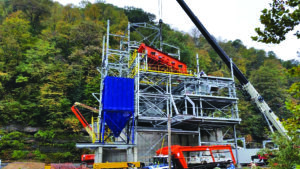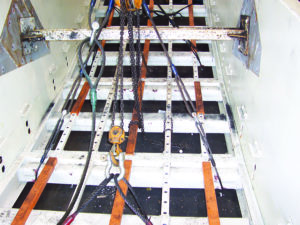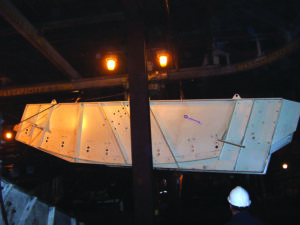
Replacing heavy plant machinery, such as screening machines and large-diameter cyclones, requires the appropriate lifting equipment. (Photo: Elgin Separation Solutions)
Visual inspections and planned maintenance can extend the life of equipment in the prep plant
by steve fiscor, editor-in-chief
Compared to working sections in an underground mine, preparation plants are much more complex mechanically per square foot. The plant’s conveyor network consists of a series of short, fixed flights that move raw coal from silos to chutes and then transfer clean coal back to silos again. Screening machines vibrate constantly segregating material by size on one end and dewatering and desliming streams on the other end. Slurry pumps serve as workhorses moving slurry between the machinery cleaning the coal based on specific gravity and dewatering the fines.
Whenever people are working around machinery, the first consideration should always be safety. Guarding should never be removed while the machinery is operating. Lock-out and tag-out policies should always be followed whenever electrically powered equipment is being serviced, whether it is an electrical issue or not. No amount of coal is worth an injury or worse.
A good maintenance program adheres to a regular routine. Even though the plant may have automated systems in place, visual inspections are still incredibly important. It is also important to follow the manufacturer’s guidelines as far as the necessary lubrication and preventive maintenance (PM intervals). Few plants can afford to shell out a pump these days, let alone see a screening machine tear itself apart.
When it comes to a major overhaul, remember the five P’s: prior planning prevents poor performance. Budgets are tight these days and mistakes could be incredibly costly to the mine and one’s career. Maintenance planners should anticipate the needs as far as the weight of the equipment being handled, the necessary replacement parts and the skill sets to accomplish the job. The object is to restore operations quickly and extend the time until the next PM.
Maintaining Slurry Pumps
The PM interval for a slurry pump depends on the application. The wet-end of a hard-iron slurry pump working in a clarified water application will last for years. The focus for these units is mainly maintaining the seals and lubrication.
The typical heavy-media prep plant with a raw feed capacity of 400 tons per hour (tph) usually employs eight slurry pumps or more and pumping heavy media is one of the highest wear applications in coal processing. “The slurry pumps used in the plant circuit, such as those used for heavy-media, cyclone feeds and thickener underflows, are working in aggressive wear situations,” said Will Pierce, engineering manager, Schurco Slurry Pumps. “With these units, PM checks must the performed on a regular schedule to plan downtime rather than reacting to downtime. It depends on the raw feed capacity and hours of operation, but we recommend a PM inspection every 1,000 hours.” That slurry pump PM would consist of opening the spool pieces and inspecting it with a flashlight to look for high wear areas. Pierce encouraged maintenance planners to be mindful of sharp edges that could pose a safety hazard. He suggested beginning the inspection with a feeler gauge first to check the gaps.
During those PMs, the technicians should also adjust the impeller. “Every slurry pump, regardless of the manufacturer, has a means of adjusting the impeller clearances within the pump casing,” Pierce said. “With some designs, the liners are adjusted into the impellers, while others would have you adjust the impeller into the liner. In either case, closing the impeller clearance against the intake side of the pump is important to reduce recirculation, increase efficiency and extend the wear life.”
It is also important to look at the shaft seals, making sure the seal water pressure is appropriate and flowing into the pump through the gland seal water port. The packing should be replaced if it is worn. “That part of the process can be a little more reactive,” Pierce said. “Packing can be replaced on a short down without disassembling the pump. Whenever the lubricators are making their rounds, servicing the rotating assembly, they can visually inspect the packing to see if it’s leaking.”
The lubrication recommendations for slurry pumps vary by manufacturer. The maintenance planner should follow the guidelines in the manual, which is usually based on rotating speed. “Most slurry pumps installed in coal processing plants are grease lubricated,” Pierce said. “The manual will describe the amount and frequency. Some plants have moved to auto-lubricators with cups mounted on grease zerks that inject grease over a set interval of time. With these cups, you still must do regular visual checks. They can become out of sight and out of mind, and then the lube cup runs dry.”
Many prep plants rely on PM scheduling systems that are fixed-time based systems. They generate a PM for the crews to inspect and it is managed at an operational level.
Pierce said that he is starting to see some of the technology associated with process chemical pumps being used for slurry pumping applications. This would include technologies such as vibration monitors, online temperature sensors, etc. “One of these systems suppliers makes a vibration monitoring device that threads into the lubrication point,” Pierce said. “Nothing on the equipment is changed, except the grease zerk, which is swapped with this device. It’s a bolt-on technology that enhances the data coming off the equipment.”
To properly prepare for a pump overhaul, Pierce suggested that maintenance technicians find a pump service manual, which includes a certified component diagram for that pump from the manufacturer, and familiarize themselves with it first. “If it’s the first time this pump is being overhauled, the technicians might be learning on the fly what needs to be replaced over time,” Pierce said. “It’s rare that you would have to replace all of the wear components on every repair.”

Knowing the rigging points and having everything staged would be the best way to prepare for a screening machine overhaul. (Photo: Elgin Separation Solutions)
Many of these decisions will be based on budgets and maintenance philosophies at the prep plant. For example, some plants keep a spare (rebuilt) pump in stock. They remove the ancillary equipment attached to the pump being serviced, remove the in-service pump, replace it with a rebuilt pump and reattach the ancillary equipment. The worn pump can be serviced at the shop onsite or they can send it to the original manufacturer or a third-party shop to be repaired. “We would consider that a managed-maintenance program,” Pierce said.
Another lower cost option, Pierce explained, would be to repair the pump in place or in-situ. “Keeping the pump installation fixed, they would remove all the connecting pipework,” Pierce said. “They should also have all the lifting equipment available along with all of the replacement parts. As they pull it apart, they would assess the situation, replace all the worn parts, and reassemble the pump. In this situation, you would want to have a rotating assembly ready-built if that component is to be replaced or repaired. Not every pump repair requires a new rotating assembly, but usually going into a repair, you would want to know whether or not you are going to do that.”
Pierce said Schurco is developing a new line of pumps for the coal business. “Our standard line of pumps is a lined pump with an outer shell that can accommodate metal and rubber liners,” Pierce said. “Coal prep applications almost always demand hard-metal pumps, and it’s a very price-sensitive industry right now. So, we are developing a lower cost pump line that does not have a large ductile iron outer shell. It is an unlined pump that has replaceable wear components. It’s a lower cost installation, but there is no compromise on the components in terms of wear performance or hydraulic characteristics.” That line of pumps will be available in the third quarter of 2020.
PMs for Screening Machines
When it comes to maintenance programs for screening machines, John Casey, vice president-sales for Elgin Separation Solutions, always emphasizes the importance of the oil change and the suspension. “Changing the oil in the vibrating mechanism is just like changing the oil in a vehicle,” Casey said. “If you take care of your vehicle, it will last longer and the same hold true for your vibrating screens.”
Elgin’s recommended PM schedule for screening machines is an oil change every 800 hours. “It’s a common misconception that the oil is broken down and that’s not usually the case,” Casey said. “The reason we recommend 800 hours is that the vibrating mechanisms have no oil filtration to trap the contaminants. Between our experience and the testing that our bearing supplier has performed, we have determined that to be the optimum interval for the oil change.”
Most screening machines use a standard coil spring as the suspension. During the PMs, the technicians should perform a visual inspection to determine if any of the coil springs have been broken, Casey explained. “A broken coil spring means the machine is running slightly twisted with more stress on the opposing corners when the spring is not handling the full weight it should be handling,” Casey said.
He suggests marking the springs to make sure that the correct coil springs are being used. “They make look the same, but some coils have a different spring rate,” Casey said.
The need for visual inspections cannot be overstated. “Although these machines last for years, they do develop stress fractures and damage due to erosion and corrosion,” Casey said. “It’s important to look for anything out of the ordinary.”
Like the bolt-on technology discussed with the slurry pumps, some of the bearing manufacturers have developed monitoring systems to help predict bearing failure before the machine experiences a catastrophic failure. That along with the vibration monitoring software that is now available are two new advantages that have become more affordable, Casey explained. “In the past, these systems were so expensive that plant operators didn’t consider them, but that has changed and some of them will link to a smart phone app,” Casey said.

Maintenance crews fly a new screening machine into place. (Photo: Elgin Separation Solutions)
For major overhauls on a screening machine, the maintenance crews are usually flying in replacement side plates or a mechanism or a mechanism mounting beam — something with substantial weight, Casey explained. “The biggest thing is knowing the rigging points,” Casey said. “A couple of times in the past, when we assisted customers with these types of rebuilds, we learned firsthand that it is helpful to know the rigging points before you start flying the equipment into the plant.”
Many of the newer prep plants have overhead cranes and newer screening machines. The older plants, however, have limited headroom and no overhead cranes. “Knowing the rigging points and having everything staged would be the best way to prepare for this type of overhaul,” Casey said.
With the today’s market situation in the coal business, it is becoming more obvious that a proper PM schedule could save prep plant operators a lot of money in the long run. It is key to a lower maintenance budget. Regular oil changes, PMs and visual inspections that prevent catastrophic failure will pay dividends in the long run.




